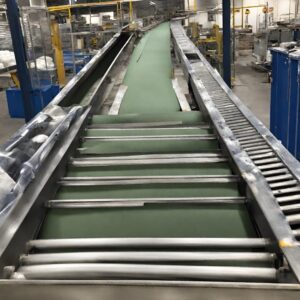In manufacturing the term “production downtime” is often met with a sense of urgency and concern. It represents periods when production halts, directly impacting a company’s operational efficiency and profitability. These interruptions can range from equipment failures to systemic operational lags, each contributing significantly to reduced efficiency and lost production time.
Downtime can be scheduled or unscheduled, in this article we focus on unscheduled downtime. As an example, scheduled downtime includes set up time when changing product, etc.
Lost production also includes losses in Quality of product and Speed losses when a production line runs at reduced speed,,
Defining Production Downtime - what it is and how to calculate it
Production downtime is a period when the manufacturing process is unexpectedly halted. It’s a critical metric in the manufacturing industry, directly affecting output, efficiency, and cost. Downtime can result from various factors, ranging from equipment failure and maintenance to supply chain disruptions and workforce challenges. Identifying and quantifying these downtimes is crucial for operational improvement.
To calculate production downtime, the most common method is to track the time from when production ceases to when it resumes. This can be represented as:
Stop time – restart time = production downtime
The basic principle is easy to calculate. However, calculating downtime isn’t solely about time. It’s about understanding the impact on production capacity and cost. For instance, if a machine with a capacity of 100 units per hour stops for 3 hours, the downtime leads to a production loss of 300 units. This loss, coupled with the costs of repairs and idle labor, contributes to the total downtime cost.
Accurate downtime calculation is not just a numeric exercise; it’s a strategic tool. It helps us identify patterns, pinpoint recurring issues, and develop targeted strategies to mitigate these disruptions. At IDCON, we stress the importance of precise downtime tracking as a foundation for efficient operational management.

What Causes Production Downtime?
Understanding the causes of production downtime is pivotal for any manufacturing entity aiming to maintain seamless operations. We need to recognize that these causes can be multifaceted and often interlinked. Here are some of the primary contributors to production downtime:
Equipment failure: This is the most direct and obvious cause. Machines age, parts wear out, and without proper maintenance, they break down. These failures can range from minor issues that require quick fixes to major breakdowns needing extensive repairs.
Human error: Even with the most advanced technologies, the human factor plays a crucial role. Errors in operation, incorrect settings, or mismanagement can all lead to unscheduled downtime. Training and clear procedures are essential to minimize these errors.
Supply chain disruptions: In today’s interconnected world, a disruption in the supply chain can halt production. Issues such as delayed raw material deliveries or logistics problems can cause significant downtime.
Systemic issues: These include software malfunctions, network issues, or power outages. In an age where manufacturing is increasingly reliant on digital systems, these problems can lead to substantial production halts.
By identifying these common causes, we can aim to tailor our approach to each unique situation. Addressing these issues requires not only technical solutions but also a strategic perspective that encompasses the entire operation process.
Dealing with Production Downtime
Encountering high unscheduled production downtime can be a challenging and costly issue for any manufacturing operation. Addressing this effectively requires a combination of immediate actions and long-term strategies:
- Immediate response and assessment: When unscheduled downtime occurs, the first step is to promptly address the issue to minimize immediate impacts. This involves quickly identifying the cause and implementing a solution, whether it’s a repair, a workaround, or an alternative production method.
- Data analysis and pattern recognition: Post-crisis, it’s crucial to analyze the event thoroughly. This involves reviewing data to understand why it happened. Was it an isolated incident or part of a recurring pattern? Understanding the underlying causes is key to preventing future occurrences.
- Training and skill development: Often, high unscheduled production downtime is a symptom of gaps in staff training and skills. Investing in comprehensive training for maintenance and operational personnel is crucial. This ensures that the team is equipped to both prevent potential issues and respond effectively when they occur.
- Developing a proactive maintenance culture: Shifting from a reactive to a proactive maintenance approach can significantly reduce high production downtime. This involves regular equipment inspections, predictive maintenance, and preemptive planned and scheduled repairs.
Handling high production downtime isn’t just about quick fixes; it’s about building a resilient and responsive system capable of adapting to challenges and minimizing their impact on production
Preventing Unscheduled Production Downtime
Preventing unscheduled production downtime is a multifaceted endeavor that requires a proactive and comprehensive approach. We advocate for several key strategies to mitigate the risk of unplanned stoppages:
Implementing preventive maintenance inspections: Utilizing predictive maintenance techniques and basic inspections such as look, listen, feel smell is a cornerstone of preventing unscheduled By monitoring the condition of equipment and predicting failures before they develop to a break down, we can schedule maintenance activities without disrupting production schedules.
Regular training and skills enhancement: Continuous training of maintenance and operational staff plays a crucial role. By staying updated on the latest techniques and understanding the nuances of the machinery they operate, employees can identify and address potential issues before they escalate into major problems.
Optimizing spare parts management: Efficient management of spare parts inventory ensures that critical components are available when needed, reducing the time taken to repair and get equipment back online.
Streamlining maintenance processes: Simplifying and standardizing maintenance processes can significantly reduce the likelihood of errors and oversights, thereby minimizing downtime.
By focusing on these proactive measures, we aim to create a robust framework that not only addresses immediate concerns but also lays the groundwork for long-term operational stability and efficiency.
How IDCON Helps your Team Reduce Production Downtime
Here at IDCON we are your partner in your journey towards production uptime. Our expertise in reducing unscheduled production downtime revolves around key strategies and tailored solutions.

Maintenance and Reliability Assessments. By uncovering the gaps in your work processes you are better able to make the right plan to meet your goals.

Expert Maintenance and Reliability Training. We provide in-depth training programs focused on both preventive and predictive maintenance and work management including planning and scheduling , Root Cause Problem elimination and spare parts management. These training courses are designed to enhance the skills of your maintenance personnel, ensuring they are well-equipped to manage and prevent downtime effectively.

Practical implementation support: Understanding that knowledge is only as good as its application, we offer hands-on support in implementing maintenance strategies on the plant floor. This ensures that the transition from theory to practice is smooth and effective.
Let IDCON be your partner in optimizing maintenance management performance to reduce production downtime. Our commitment to your success and our comprehensive range of services are designed to help your team be more unified and efficient. Contact us today to learn more about how we can help you achieve your production goals.





